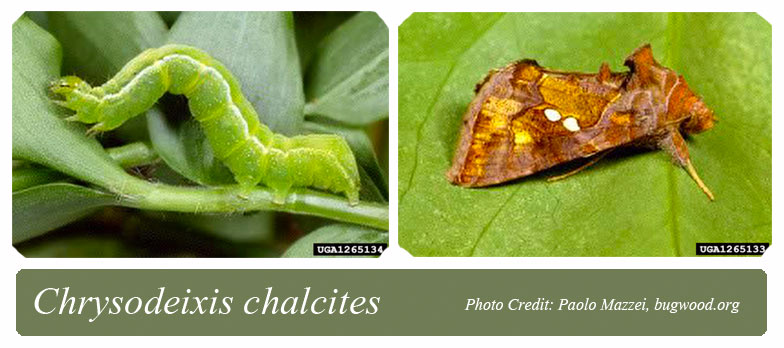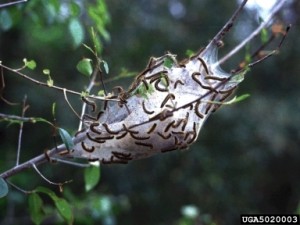California Pest Rating for
Cnephasia stephensiana Doubleday: Grey Tortrix
Lepidoptera: Tortricidae
Pest Rating: A
PEST RATING PROFILE
Initiating Event:
In August 2015, the United States Department of Agriculture (USDA) distributed a New Pest Advisory Group (NPAG) report that proposed to establish a non-reportable/non-actionable policy for Cnephasia stephensiana1. An updated version of the report was distributed in August 2017. A pest rating proposal is required to assign a permanent rating to this pest.
History & Status:
Background: Cnephasia stephensiana is a polyphagous moth that feeds on the leaves of more than 120 species of plants1. First instar caterpillars mine leaves; later instars live externally within spun leaves1. Caterpillars may also feed on flowers1. As caterpillars identified as Cnephasia sp. have only been intercepted by USDA five times1, it is presumed that members of this genus are rarely moved in trade. The moth is thought to disperse primarily through flight1.
Worldwide Distribution: Cnephasia stephensiana is native to Europe and Russia1. It has been found in Japan1. It was first found in Canada (in Nova Scotia) in 19542 and has since spread across that country1. In the United States, it has been collected in Maine, Massachusetts, New Hampshire, New York, Pennsylvania, Vermont, and the state of Washington1.
Official Control: Cnephasia stephensiana is not known to be under official control in any other states or nations. However, Cnephasia jactatana is listed as a harmful organism by Japan and Korea and Cnephasia longana is listed as a harmful organism by Chile, Ecuador, Korea, and South Africa3. The entire family Tortricidae is considered harmful by Japan3.
California Distribution: Cnephasia stephensiana has never been found in the environment of California.
California Interceptions: Cnephasia stephensiana has never been intercepted by CDFA or the County Agricultural Commissioners.
The risk Cnephasia stephensiana (grey tortrix) would pose to California is evaluated below.
Consequences of Introduction:
1) Climate/Host Interaction: The present range of Cnephasia stephensiana overlaps with USDA plant hardiness zones 4-81. This corresponds with northern and high-elevation regions of California. Due to its polyphagous nature, the moth is likely to encounter suitable host plants in California. It receives a Medium (2) in this category.
Evaluate if the pest would have suitable hosts and climate to establish in California. Score:
– Low (1) Not likely to establish in California; or likely to establish in very limited areas.
– Medium (2) may be able to establish in a larger but limited part of California.
– High (3) likely to establish a widespread distribution in California.
2) Known Pest Host Range: Cnephasia stephensiana is polyphagous and known to feed on more than 120 species of plants. It receives a High (3) in this category.
Evaluate the host range of the pest. Score:
– Low (1) has a very limited host range.
– Medium (2) has a moderate host range.
– High (3) has a wide host range.
3) Pest Dispersal Potential: Each female Cnephasia stephensiana can lay 300-400 eggs, indicating a high reproductive rate. It rarely moves in trade and disperses locally by flying. Grey tortrix receives a Medium (2) in this category.
Evaluate the natural and artificial dispersal potential of the pest. Score:
– Low (1) does not have high reproductive or dispersal potential.
– Medium (2) has either high reproductive or dispersal potential.
– High (3) has both high reproduction and dispersal potential.
4) Economic Impact: Cnephasia stephensiana is not considered to be a pest in locations where it is abundant and is therefore not expected to lower crop yields or reduce crop values. The moth rarely moves in trade and is not under official control in any states or nations, indicating that trade disruptions should be minimal. It is not expected to change cultural practices, vector other organisms, injure animals, or interfere with water supplies. It receives a Low (1) in this category.
Evaluate the economic impact of the pest to California using the criteria below.
Economic Impact: None
A. The pest could lower crop yield.
B. The pest could lower crop value (includes increasing crop production costs).
C. The pest could trigger the loss of markets (includes quarantines).
D. The pest could negatively change normal cultural practices.
E. The pest can vector, or is vectored, by another pestiferous organism.
F. The organism is injurious or poisonous to agriculturally important animals.
G. The organism can interfere with the delivery or supply of water for agricultural uses.
Economic Impact Score: 1
– Low (1) causes 0 or 1 of these impacts.
– Medium (2) causes 2 of these impacts.
– High (3) causes 3 or more of these impacts.
5) Environmental Impact: If Cnephasia stephensiana were to establish in California, it is not likely to lower biodiversity, disrupt natural communities, or change ecosystem processes. Due to its polyphagous nature, it is likely to feed on threatened or endangered species. The moth is not expected to disrupt critical habitats, nor is it expected to trigger new treatment programs. It is also not expected to significantly impact cultural practices, home/urban gardens, or ornamental plants. Cnephasia stephensiana receives a Medium (2) in this category.
Evaluate the environmental impact of the pest on California using the criteria below.
Environmental Impact: C
A. The pest could have a significant environmental impact such as lowering biodiversity, disrupting natural communities, or changing ecosystem processes.
B. The pest could directly affect threatened or endangered species.
C. The pest could impact threatened or endangered species by disrupting critical habitats.
D. The pest could trigger additional official or private treatment programs.
E. The pest significantly impacts cultural practices, home/urban gardening or ornamental plantings.
Score the pest for Environmental Impact. Score: 2
– Low (1) causes none of the above to occur.
– Medium (2) causes one of the above to occur.
– High (3) causes two or more of the above to occur.
Consequences of Introduction to California for Cnephasia stephensiana (Grey tortrix):
Add up the total score and include it here.
–Low = 5-8 points
–Medium = 9-12 points
–High = 13-15 points
6) Post Entry Distribution and Survey Information: Cnephasia stephensiana has not been found in California and receives a Not established (0) in this category.
Evaluate the known distribution in California. Only official records identified by a taxonomic expert and supported by voucher specimens deposited in natural history collections should be considered. Pest incursions that have been eradicated, are under eradication, or have been delimited with no further detections should not be included.
–Not established (0) Pest never detected in California, or known only from incursions.
–Low (-1) Pest has a localized distribution in California, or is established in one suitable climate/host area (region).
–Medium (-2) Pest is widespread in California but not fully established in the endangered area, or pest established in two contiguous suitable climate/host areas.
–High (-3) Pest has fully established in the endangered area, or pest is reported in more than two contiguous or non-contiguous suitable climate/host areas.
Final Score:
The final score is the consequences of introduction score minus the post entry distribution and survey information score: Medium (10)
Uncertainty:
Because of its large host range, there is a lot of uncertainty with this moth in California. It could encounter specialty crops in the state that it has not encountered in other states. If this were to occur, there could be disruptions to markets for California’s fresh fruit exports, such as strawberries to Mexico. There have not been any recent formal surveys for Cnephasia stephensiana in California. It is possible that it is present in some localities in California.
Conclusion and Rating Justification:
Cnephasia stephensiana has never been found in California. If it were to establish in the state, it is likely to have some economic and environmental impacts. An “A” rating is justified.
References:
1 Landry, Cynthia 2014. NPAG Report Cnephasia stephensiana Doubleday: Grey tortrix. New Pest Advisory Group (NPAG). Plant Epidemiology and Risk Analysis Laboratory. Center for Plant Health Science & Technology. Contact npag@aphis.usda.gov for this report.
2 Mutuura, Akira. 1982. Cnephasia stephensiana, a species newly recorded from Canada and compared with the previously recorded C. interjectana (Lepidoptera: Tortricidae). The Canadian Entomologist 114(08):667-671. http://journals.cambridge.org/action/displayAbstract?fromPage=online&aid=8552795&fileId=S0008347X00039225
3 USDA Phytosanitary Certificate Issuance & Tracking System (PCIT) Phytosanitary Export Database (PExD). https://pcit.aphis.usda.gov/pcit/
Responsible Party:
Jason Leathers, 1220 N Street, Sacramento, CA, 95814, (916) 654-1211, plant.health[@]cdfa.ca.gov.
Comment Period: CLOSED
9/18/2017 – 11/2/2017*
*NOTE:
You must be registered and logged in to post a comment. If you have registered and have not received the registration confirmation, please contact us at plant.health[@]cdfa.ca.gov.
Comment Format:
♦ Comments should refer to the appropriate California Pest Rating Proposal Form subsection(s) being commented on, as shown below.
Example Comment:
Consequences of Introduction: 1. Climate/Host Interaction: [Your comment that relates to “Climate/Host Interaction” here.]
♦ Posted comments will not be able to be viewed immediately.
♦ Comments may not be posted if they:
Contain inappropriate language which is not germane to the pest rating proposal;
Contains defamatory, false, inaccurate, abusive, obscene, pornographic, sexually oriented, threatening, racially offensive, discriminatory or illegal material;
Violates agency regulations prohibiting sexual harassment or other forms of discrimination;
Violates agency regulations prohibiting workplace violence, including threats.
♦ Comments may be edited prior to posting to ensure they are entirely germane.
♦ Posted comments shall be those which have been approved in content and posted to the website to be viewed, not just submitted.
PEST RATING: A
Posted by ls




